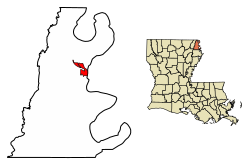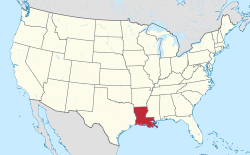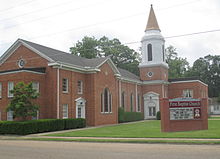
Chicot County is a county located in the southeastern corner of the U.S. state of Arkansas. As of the 2020 census, the population was 10,208. The county seat is Lake Village. Chicot County is Arkansas's 10th county, formed on October 25, 1823, and named after Point Chicot on the Mississippi River. It is part of the Arkansas Delta, lowlands along the river that have been historically important as an area for large-scale cotton cultivation.

West Carroll Parish is a parish located in the northeastern part of the U.S. state of Louisiana. As of the 2020 census, the population was 9,751. The parish seat is Oak Grove. The parish was founded in 1877, when Carroll Parish was divided.

Tensas Parish is a parish located in the northeastern section of the State of Louisiana; its eastern border is the Mississippi River. As of the 2020 census, the population was 4,147. It is the least populated parish in Louisiana. The parish seat is St. Joseph. The name Tensas is derived from the historic indigenous Taensa people. The parish was founded in 1843 following Indian Removal.
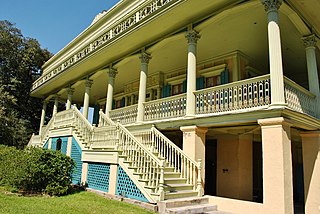
St. John the Baptist Parish is a parish located in the U.S. state of Louisiana. At the 2020 census, the population was 42,477. The parish seat is Edgard, an unincorporated area, and the largest city is LaPlace, which is also unincorporated.

Ouachita Parish is located in the northern part of the U.S. state of Louisiana. As of the 2020 census, the population was 160,368. The parish seat is Monroe. The parish was formed in 1807.

East Carroll Parish is a parish located in the Mississippi Delta in northeastern Louisiana. As of 2020, its population was 7,459. The parish seat is Lake Providence. An area of cotton plantations in the antebellum era, the parish in the early 21st century has about 74% of its land devoted to agriculture.

Concordia Parish borders the Mississippi River in eastern central Louisiana. As of the 2020 census, the population was 18,687. The parish seat is Vidalia. The parish was formed in 1807.

Harrisonburg is a village in and the parish seat of Catahoula Parish, Louisiana, United States. The population was 348 as of the 2010 census, down from 746 in 2000.
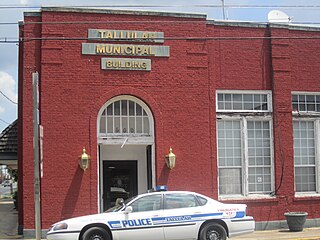
Tallulah is a city in, and the parish seat of, Madison Parish in northeastern Louisiana, United States. As of the 2020 census, the population was 6,286, down from 7,335 in 2010.

Newellton is a town in northern Tensas Parish in the northeastern part of the U.S. state of Louisiana. The population is 1,187 in the 2010 census, a decline of 255 persons, or 17 percent, from the 2000 tabulation of 1,482. The average age of the population there is 41 years.

St. Joseph, often called St. Joe, is a town in, and the parish seat of, rural Tensas Parish in northeastern Louisiana, United States, in the delta of the Mississippi River. The population was 1,176 at the 2010 census. The town had an African-American majority of 77.4 percent in 2010.
The Natchez District was one of two areas established in the Kingdom of Great Britain's West Florida colony during the 1770s – the other being the Tombigbee District. The first Anglo settlers in the district came primarily from other parts of British America. The district was recognized to be the area east of the Mississippi River from Bayou Sara in the south and Bayou Pierre in the north.

Joseph Eugene Ransdell was an attorney and politician from Louisiana. Beginning in 1899, he was elected for seven consecutive terms as United States representative from Louisiana's 5th congressional district. He subsequently served for three terms in the United States Senate from Louisiana before being defeated in the 1930 Democratic primary for the seat by Governor Huey Long.
Edward Sparrow was an American politician who served as a Confederate States Senator from Louisiana from 1862 to 1865.
The Battle of Richmond was fought on June 15, 1863, near Richmond, Louisiana, during the Vicksburg campaign of the American Civil War. Major General John George Walker's division of Confederate troops, known as Walker's Greyhounds had attacked Union forces in the Battle of Milliken's Bend and the Battle of Lake Providence earlier that month in hopes of relieving some of the pressure on the Confederate troops besieged in Vicksburg, Mississippi. While both of Walker's strikes were failures and the Confederates withdrew to Richmond, Union Major General Ulysses S. Grant still viewed the presence of Walker's men at Richmond to be a threat. On June 14, the Mississippi Marine Brigade and the infantry brigade of Brigadier General Joseph A. Mower were sent to attack the Confederates at Richmond.
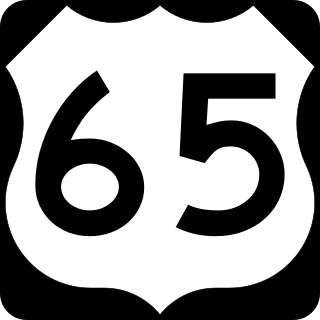
U.S. Highway 65 (US 65) is a part of the United States Numbered Highway System that spans 966 miles (1,555 km) from Clayton, Louisiana to Albert Lea, Minnesota. Within the state of Louisiana, the highway travels 100.77 miles (162.17 km) from the national southern terminus at US 425/LA 15 in Clayton to the Arkansas state line north of Lake Providence.
Jefferson B. Snyder, was a lawyer and politician from the Mississippi River delta country of northeastern Louisiana. Snyder became a virtual political boss of Madison, Tensas, and East Carroll parishes; his leadership was rarely challenged, and politicians courted his endorsements.

Norris Charles Craft Williamson was a Democrat who served from 1924 to 1932 in the Louisiana State Senate. A resident of Lake Providence, Williamson represented the delta parishes: Tensas, Madison, East Carroll, and Concordia, a rich farming region along the Mississippi River. Included in his district were Vidalia, Ferriday, St. Joseph, and Tallulah. At the time, two state senators represented the four-parish district.
George Henry Clinton was a chemist, lawyer, and Democratic politician from St. Joseph in Tensas Parish in the northeastern Mississippi River delta of the U.S. state of Louisiana.

